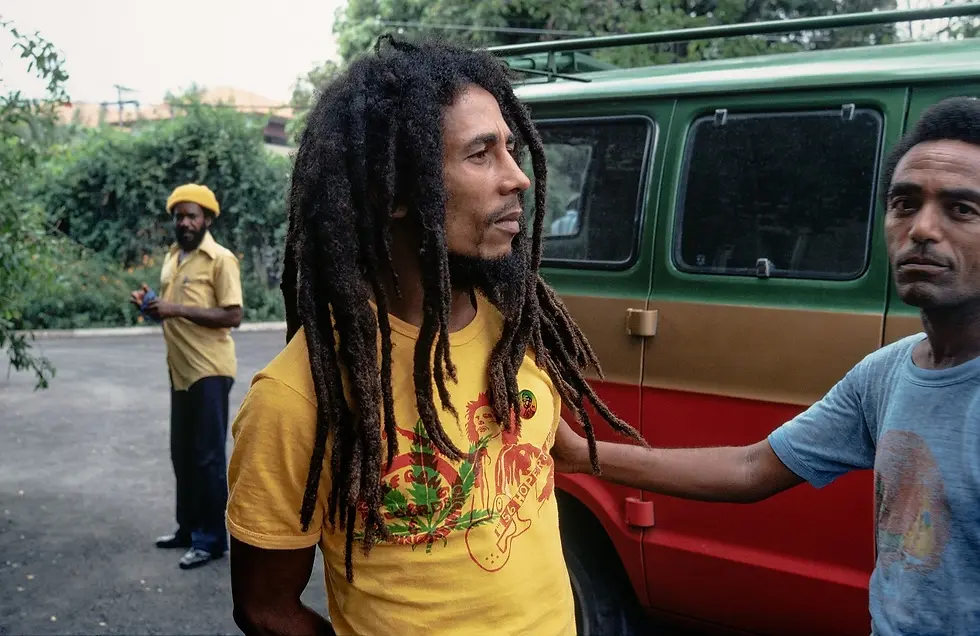When Bob Marley Survived Getting Shot During A Home Invasion
- Daniel Holland

- Dec 3, 2022
- 7 min read

It is almost impossible to listen to a Bob Marley song and picture the man ducking bullets in his own home. Yet that’s precisely what happened one tense December evening in 1976, when political rivalry, foreign meddling, and Marley’s immense influence on the streets of Kingston collided in a hail of gunfire at 56 Hope Road.
Kingston on Edge
To understand how Bob Marley, a prophet of peace, ended up a target, you have to picture mid-1970s Kingston. It was less a city and more a chessboard for two bitterly opposed political parties: the Jamaican Labour Party (JLP), rumoured to have CIA backing, and the People’s National Party (PNP), which leaned left and flirted with Cuba and Moscow. In that atmosphere, every street corner felt on edge, and music, especially Marley’s brand of socially conscious reggae, was never just music.

In 1972, Marley and his wife Rita lent their voices to support Michael Manley and the PNP. But by 1976, he was trying to steer clear of overt politics. Inspired by seeing Stevie Wonder perform in Jamaica the year before for blind children, Marley dreamed up a free concert, the Smile Jamaica show, to soothe a nation splitting at the seams. He wanted no politics, no endorsements. Just music.
The problem was, both parties saw Marley’s presence as an endorsement whether he liked it or not. The PNP cunningly scheduled a snap election to coincide with Marley’s gig, effectively turning Smile Jamaica into free advertising for Manley’s government. Marley felt cheated, he had agreed to perform only if politics stayed out of it, but once things were in motion, there was no polite way to cancel.
Trouble Rolls Up at Hope Road
As the date for Smile Jamaica drew closer, the mood around Kingston’s musical kingpin grew ever more restless. Bob Marley, who many viewed as the one true voice capable of bridging Jamaica’s widening political chasm, found himself at the centre of whispered threats and brazen warnings. Strangers loitered outside his gates at all hours, suspicious vehicles crawled along Hope Road in the dead of night, and word on the street was that both rival factions saw Marley’s neutrality as too risky to tolerate. He was, whether he liked it or not, a living symbol — and that made him a target.

To calm mounting fears, the authorities assigned uniformed officers to guard Marley’s two-storey colonial-style house at 56 Hope Road, a sprawling, slightly ramshackle sanctuary where rehearsals, impromptu jam sessions, and communal meals flowed as freely as the ganja smoke. But the guards were few, lightly armed, and no match for the raw, heavily armed gangs that Kingston’s political bosses quietly kept on their payroll.
Marley tried to keep the atmosphere normal. He rehearsed with the Wailers, he laughed with his children who darted through the house barefoot, he rolled fat spliffs on the kitchen counter. Friends, journalists, and local well-wishers drifted in and out — the door was rarely locked. All the while, Marley knew, somewhere in the back of his mind, that the wrong knock might come sooner rather than later.
That knock arrived just after dusk on 3 December 1976. Two nondescript white Datsuns — boxy Japanese saloons common on Kingston’s streets — slowed to a crawl by the front gates. Inside the house, the Wailers were deep in rehearsal for I Shot The Sheriff, their version of a defiant outlaw tale that felt, at that moment, eerily appropriate.
Tyrone Downie, the Wailers’ talented young keyboardist, later painted the scene vividly: “We were working on I Shot The Sheriff when Bob stepped out, he wanted to grab a grapefruit from the kitchen. The horns section were messing about, trying to lay a line that didn’t belong on the tune.”
Bob padded barefoot towards the kitchen, knife in hand, no idea that trouble was already spilling over the gate. Outside, Rita Marley, who had just returned from an errand, stepped from her car, and never saw the first gunman raise his weapon. A shot cracked the night; the bullet skimmed the crown of her head, tearing her scalp but sparing her life by a hair’s breadth.
Inside, the front door burst open. One gunman stuck his arm round first, revolver in hand, a grim silhouette against the hallway light. Shots rang out at point-blank range. Marley staggered as bullets grazed his chest and lodged in his arm. He doubled over but did not fall.
In the confusion, Don Taylor, Marley’s American-born manager, a sharp-suited man known for his business hustle as much as his loyalty, took multiple rounds to his legs and abdomen. Louis Griffiths, a loyal employee helping set up the show, was hit too. Screams and the echo of ricocheting bullets turned Hope Road’s laid-back sanctuary into a battlefield in seconds.
Then, just as suddenly, it was over. The shooters fled, their white Datsuns squealing off into Kingston’s maze of darkened streets. The silence that settled over the bullet-pocked house felt thick and suffocating.

Nancy Burke, a family friend, had dropped by to say hello — now she was frozen, pinned to the wall by dread. “The silence after seemed like forever, which was even more terrifying,” she told the BBC decades later. When the stillness broke, it was with the sound of someone shouting, “Diane, Diane, come quick, Bob is shot!”
Burke stumbled out into the corridor just in time to see Marley himself, astonishingly upright, face twisted in anger and disbelief, cradling his bloodied arm as uniformed policemen flanked him out the door. Despite the chaos, despite the pain, Marley’s eyes burned with the defiance that would carry him onto the Smile Jamaica stage just two days later, bullet and all.

Who Pulled the Trigger?
Rumours raced through Kingston within hours. Neighbours swore the gunmen sped back to Tivoli Gardens, a stronghold for the JLP and its feared enforcers, the Shower Posse. Some pointed fingers at Edward Seaga, the JLP leader, and his notorious bodyguard, Lester “Jim Brown” Coke — a name that would loom large in Jamaican gangland history.
One of Marley’s bandmates reportedly muttered, “Is Seaga men! Dem come fi kill Bob!” According to Don Taylor, the wounded manager, he later sat in a courtroom watching the captured gunmen testify. Before one of them was executed, Taylor claimed the shooter confessed they had done it for the CIA — with guns and cocaine offered as payment.
A secret cable from the American embassy, blandly titled “Reggae Star Shot”, acknowledged the whole world knew what many whispered in Jamaica: Marley’s music and influence had become a pawn in a much bigger game.
A House Transformed into a Fortress
In the immediate aftermath, 56 Hope Road was chaos of a kind it had never seen. The band’s instruments still lay scattered across the rehearsal room floor, amplifiers buzzing in the sudden hush, while blood stained the hall tiles near the kitchen. Those who had not been hit huddled together, some crying, some just stunned into silence.

Rita Marley, remarkably lucid despite the bullet wound along her scalp, was the first to be rushed towards a car waiting to take her to University Hospital. Neighbours, drawn out by the gunfire, pressed against the property’s iron gates, whispering that the beloved Marley family had just cheated death. Someone, nobody quite remembers who, tied a piece of cloth around Don Taylor’s thigh to slow the bleeding from his leg while waiting for an ambulance that seemed to take an eternity.
Bob himself refused to be carried. Witnesses said he paced the front porch, glaring at the gates as if daring the gunmen to come back and finish the job. When police tried to convince him to stay down and wait for treatment, he waved them away, demanding to see Rita first. When he was finally persuaded to sit, he lit a spliff with shaking hands.
Word spread through Kingston like brushfire, Gunman shoot Bob! Radio disc jockeys interrupted reggae sets to confirm it. Within the hour, armed supporters and curious onlookers gathered near Hope Road. Some brought makeshift weapons, machetes, sticks, even lengths of iron pipe. For a while, nobody knew if the attackers might return to finish what they’d botched.
Inside the house, close friends and musicians did what they could to secure the property. Doors were bolted for the first time in months. Curtains were drawn. A few trusted men with licensed firearms stationed themselves at the windows. What had been an open, musical commune for Kingston’s poor, Rastafarian faithful, and curious tourists alike was, overnight, turned into a guarded stronghold.
Yet through it all, Marley’s main worry was not revenge but whether the Smile Jamaica concert could still go ahead. Some argued he should flee the island that very night — there were murmurs that whoever ordered the hit would not give up so easily. His manager Don Taylor, recovering in hospital, urged him to leave. Even the police recommended it. But Marley, with that unshakable sense of purpose that earned him the nickname Tuff Gong, refused.
Hospital and Bullet Lodged for Life
A doctor at University Hospital later told reporters that Marley was lucky beyond reason: the bullet that struck his chest deflected off his sternum and burrowed into his left arm, missing vital organs by a whisker. Removing it risked permanent nerve damage to his fingers, fingers he needed to hold a guitar pick and play a guitar. So the bullet stayed, a painful, constant reminder beneath his skin for the rest of his days.
Rita too was stitched up and sent home sooner than any surgeon would have advised. She returned to Hope Road, head wrapped in white gauze, helping reassure her children, who were by then terrified to sleep under their own roof.
That night, and the next, friends kept vigil. Some slept in cars parked across the drive. Others stayed awake listening for engine noises in the dark. Marley, despite the physical pain, refused to hide. He gave interviews from his armchair, bandaged and defiant, telling foreign reporters that bullets would not silence his message.

The Stage Awaits
Two nights later, on 5 December, the National Heroes Park, where Smile Jamaica was set to happen, bristled with soldiers and police. Rumours swirled that snipers might be waiting in the trees. Some fans stayed home, fearing more violence. Yet when Marley appeared, arm strapped to his side, dreadlocks framing a tired but determined face, 80,000 people roared as one.
Marley lifted his injured arm skyward during War and Crazy Baldhead, songs that sounded less like entertainment that night and more like a challenge thrown at the entire corrupt system that had tried to shut him up.
When asked later why he performed instead of resting or hiding, Marley gave an answer that became legend: “The people who are trying to make this world worse aren’t taking a day off. How can I?”
When the lights dimmed after the final encore, he slipped away quietly through the backstage shadows. By dawn, Bob Marley was on a flight out of Jamaica, bullet still inside him, he wouldn't return home for a year.
Sources:
Stephen Davis, Bob Marley: Conquering Lion of Reggae
Timothy White, Catch A Fire: The Life of Bob Marley
BBC News archives
Face2Face Africa: www.face2faceafrica.com/article/bob-marley-assassination-attempt










































































































Comments